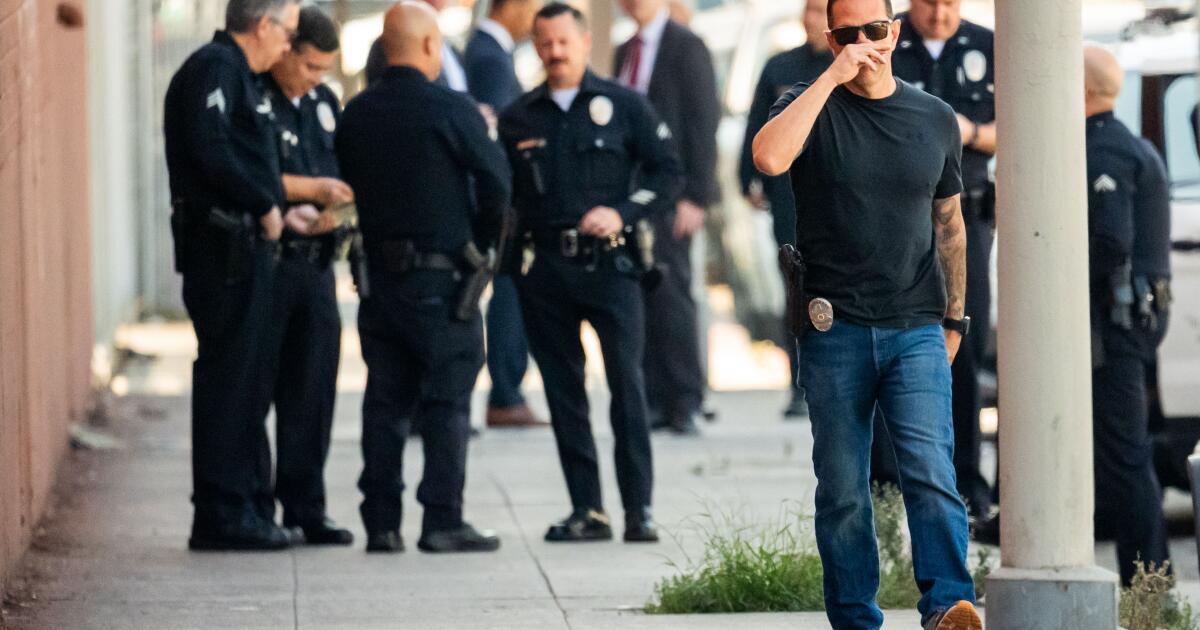In a dense South Los Angeles neighborhood, TikTok streamer Carlitos Ricardo Parias revved his engine but was pinned in by the vehicles of federal agents on all sides.
Video taken of the incident Tuesday morning — in which Parias and a deputy U.S. marshal were shot — captures the moment he tries to escape, spinning his car tires, and sending smoke billowing into the air, as agents stand just several feet away.
“Shoot him with a pepper ball,” an agent yells out.
Then 11 gunshots ring out.
“Me dieron un balazo,” Parias can be heard yelling. They shot me.
The shooting is one of several during the Trump administration’s crackdown on unauthorized immigrants where agents have become increasingly aggressive in carrying out operations. In Southern California and Chicago, where the operations have been most intense, agents have shot at suspects in cars, alleging that they were rammed, were hit by the vehicle or were in danger. In one case, a man was killed.
Federal authorities accuse Parias, a 44-year-old well-known TikTok streamer of local breaking news, of ramming his car into agents’ vehicles after they boxed him in and tried to arrest him during an immigration enforcement operation. He is being charged with assault on a federal officer. It wasn’t his first run-in with immigration agents.
In June, agents stopped Parias in a traffic stop, according to the LAPD. They pulled over the car he was in because it blew through a red light and appeared to be following them. Video that day captured Parias wearing a black press vest, handcuffed and surrounded by agents as he writhed in pain, holding his leg. Agents later let him hobble away as a crowd recorded and said, “Let him go.”
Parias and the deputy marshal remained hospitalized Wednesday. Authorities say the officer was struck by a ricocheting bullet.
In a statement, Department of Homeland Security Assistant Secretary Tricia McLaughlin said both were in “stable condition and awaiting non-life-threatening surgery.”
“Homeland Security Investigations is perusing criminal charges for assaulting, resisting, or impeding federal law enforcement.”
The Trump administration has largely defended the tactics used during the operations, saying that officers face serious threats.
Acting U.S. Atty. Bill Essayli said in a post on X that Parias rammed his car into law enforcement vehicles in front of and behind him, “spun the tires, spewing smoke and debris into the air, causing the car to fishtail and causing agents to worry for their safety.”
“An agent breaking the Camry’s driver’s side window was not enough to subdue Parias,” he said.
Department of Homeland Security policy prohibits officers from firing at a moving vehicle, when no other weapon is present, unless there is a legitimate threat to their life or the lives of others.
“Firing into moving vehicles is not standard law enforcement practice except in very extreme conditions,” said Deborah Fleischaker, a former chief of staff of Immigration and Customs Enforcement. “You don’t want to do it unless life and limb is at risk.”
The recent news of federal agents firing into cars “makes you wonder what has changed. Has previous policy been revoked? Has training changed? Has supervisor instruction changed?”
Use of force experts say major police agencies discourage officers from shooting at vehicles being driven at them because it can actually increase the risk of friendly fire incidents and make it harder for officers to get out of the way if the driver loses control.
The immigration operation unfolded not far from a high school and in a largely Latino neighborhood. Federal agents had set up surveillance on Parias, whom they wanted to detain on an immigration warrant, according to a criminal complaint charging the TikTok streamer.
As Parias left his driveway in a gray Toyota Camry on Tuesday morning, an Enforcement and Removal Operations agent parked his Dodge Durango in front of him to prevent him from driving away and turned on the emergency lights, according to an affidavit of a special agent with Homeland Security Investigations.
An HSI agent then used a Ford Escape to block the car on one side and a Dodge Ram driven by a deputy marshal parked behind.
According to the complaint, agents then approached the car and told Parias to exit for an arrest. When he didn’t and allegedly began backing up and moving forward, hitting the vehicles in front and behind him, an agent attempted to break the driver’s side window.
When the rear of the car began to “fishtail,” it “caused the agents to fear that PARIAS may lose control of the Camry and hit them,” said an HSI agent, whose name was redacted in the complaint. The agent wrote that Parias’ acceleration of the Camry “caused debris (likely rubber being shed from the tires themselves) to fly into the air, which struck some of the agents.”
“No department I know of would have sanctioned this intervention — that is the bottom line,” said Edward Obayashi, a Northern California sheriff’s deputy and law enforcement legal advisor who has helped craft use of force policies in regards to shooting at vehicles.
Obayashi said boxing a vehicle “is a dangerous maneuver in itself” and puts officers in exposed positions.
Video from the scene depicts Parias spinning the car’s wheels and revving his engine, but there is no clear footage or audio of him attempting to “ram” federal agents or city police officers, nor of the agents’ cars being moved by the Camry.
In a video reviewed by The Times, the gunfire erupts just after the revving has paused or stopped.
Still images and video show agents around the vehicle; in one case an immigration agent is holding a gun aimed at Parias while another agent is standing in front of him.
A law enforcement source, who was not authorized to discuss the case, said that federal agents were so overwhelmed at the chaotic scene that they pointed their firearms at arriving LAPD officers.
ICE and Border Patrol agents are likely to find themselves in similar situations going forward, as the Trump administration ramps up its deportation efforts, said Chuck Wexler, executive director of the Police Executive Research Forum, a Washington D.C.-based nonprofit.
Although he is unfamiliar with ICE training methods, he said agents should be directed not to position themselves in a vehicle’s potential path given the high likelihood targets of deportation will flee.
“I think the danger is significant for ICE agents because if they’re stopping someone, and they’re standing in front of the vehicle, and that person is in the country illegally, the consequences are high for them,” he said.
Last month, an ICE agent shot and killed Silverio Villegas González in Franklin Park, a suburb of Chicago, after he allegedly tried to flee an arrest and dragged the agent a “significant distance,” according to officials.
Video from the scene that was obtained by the Chicago Sun-Times, however, shows the agent describing his injuries as “nothing major.” A witness also told the newspaper he saw agents coming up to Villegas González’s vehicle after it crashed, and that there was no dragging incident.
In a separate incident, a Border Patrol agent shot at Marimar Martinez five times in Chicago this month after she allegedly rammed their car. She was charged with assault on a federal employee and pleaded not guilty. Her attorneys have argued that video footage shows that she was rammed by agents, not the other way around.
In San Bernardino, federal agents shot into a vehicle in August during an immigration stop; they accused the occupants of ramming their vehicle and hitting agents. Charges were filed, but the case was later dismissed.
Then last week, ICE agents told police in Oxnard that a local activist had rammed one of their vehicles before an arrest. Video released by the activist group VC Defensa appeared to show the opposite — an unmarked Jeep Cherokee with tinted windows slamming into the car of Leo Martinez, who was then arrested.
-
Share via
In a video of the aftermath of the Parias shooting, he is seen sinking to his knees, his hands seemingly cuffed behind his back. He is screaming that he’s been shot and is in pain, as authorities huddle around him.
Firefighters eventually arrived on the scene and began cutting open his shirt to see the wound.
“Ayudenme,” Parias screamed. “Help me.”
First Appeared on
Source link













